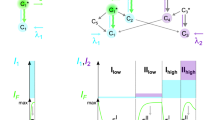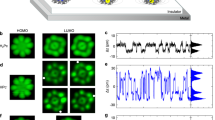Abstract
ACCORDING to Kautsky and his collaborators1, the majority of the molecules of dyes investigated by them, among which were also the molecules of fluoresceine, show an ability to phosphoresce when ‘energetically isolated’, for example, when adsorbed by convenient adsorbents. We can assume therefore that in such molecules there must be at least one metastable energy level M (Fig. 1), situated lower than the level F reached immediately after absorption. From the state F the molecules can pass either to a normal state N, emitting the band F—N (fluorescence), or to the metastable state M. The probability of the transition M—N is very small. Therefore when the temperature is sufficiently high, a great majority of molecules will be raised thermally from the level M to F and will be able to emit the band F—N (phosphorescence at room temperature). At low temperatures, direct transitions M—N take place. These transitions are accompanied by the emission of a phosphorescence band which is displaced towards the red relatively to band F—N; the duration of phosphorescence increases greatly (phosphorescence at low temperatures).
This is a preview of subscription content, access via your institution
Access options
Subscribe to this journal
Receive 51 print issues and online access
$199.00 per year
only $3.90 per issue
Buy this article
- Purchase on Springer Link
- Instant access to full article PDF
Prices may be subject to local taxes which are calculated during checkout
Similar content being viewed by others
References
Kautsky, H., "Energieumwandlungen an Grenzflächen". Ber Deutsch. Chem. Ges., 64, 2053 and 2677; 1931; and 65, 401; 1932.
O. Stern and M. Volmer, Phys. Z., 20, 183; 1919.
S. Valentiner and M. Rössiger, Z. Phys., 36, 81 ; 1926.
S. I. Wawilow, Z. Phys., 42, 311; 1927.
A. Jabloski, Acta Phys. Pol., 2, 97; 1933.
A. Jabloski, Z. Phys., 73, 460; 1931. See also P. Pringsheim, "Handb. d. Phys.", 23, Part 1, second edition, 244.
Author information
Authors and Affiliations
Rights and permissions
About this article
Cite this article
Jablonski, A. Efficiency of Anti-Stokes Fluorescence in Dyes. Nature 131, 839–840 (1933). https://doi.org/10.1038/131839b0
Issue Date:
DOI: https://doi.org/10.1038/131839b0
This article is cited by
-
Charge trapping for controllable persistent luminescence in organics
Nature Photonics (2024)
-
Photothermal conversion mechanism of the dibenzotetrathiafulvalene-tetracyanobenzene cocrystal based on the transitions between the ground and excited states
Science China Materials (2024)
-
Mosquito larvae exposed to a sublethal dose of photosensitive insecticides have altered juvenile development but unaffected adult life history traits
Parasites & Vectors (2023)
-
Focus image scanning microscopy for sharp and gentle super-resolved microscopy
Nature Communications (2022)
-
Polymeric Nanoparticles in Hybrid Catalytic Processing and Drug Delivery System
Topics in Catalysis (2022)
Comments
By submitting a comment you agree to abide by our Terms and Community Guidelines. If you find something abusive or that does not comply with our terms or guidelines please flag it as inappropriate.



